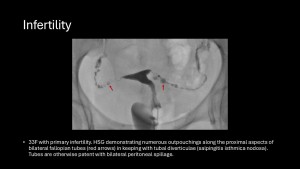Fallopian tube pathology typically causes luminal obstruction and dilatation, thereby enabling visualisation on cross-sectional imaging as they are usually only seen if dilated. There may be associated mural thickening, hyperaemia, mass, and/or adjacent free fluid. The tubal contents can also aid in differentiating between conditions.

Hydrosalpinx
Hydrosalpinx is a fluid-filled dilatation of the fallopian tubes caused by tubal obstruction, usually due to pelvic adhesions.
- The occlusion can be at the ampullary segment or both medial and lateral ends.
- It can be unilateral or bilateral.
- It can be an isolated finding or part of a more complex pathological process, such as previous pelvic inflammatory disease or endometriosis.
The tube blockage results in a characteristic sausage-shaped appearance.

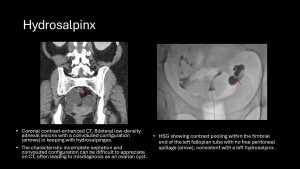
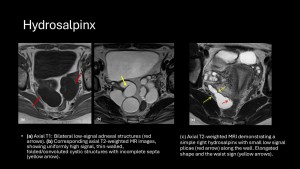
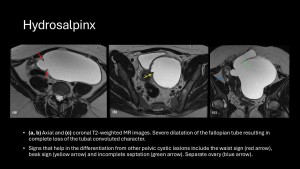
Haematosalpinx
Haematosalpinx is the dilatation of the fallopian tubes with blood or blood products.
- The most common cause is endometriosis, and this occurs due to peritubal adhesions/scarring and tubal endometriotic deposits with cyclical haemorrhage.
- In the acute setting, ectopic pregnancy and adnexal torsion should be excluded.
- Malignancy can also be a cause, albeit rare, and the tubes should be evaluated for focal wall thickening or enhancing soft tissue projection.
Endometriosis
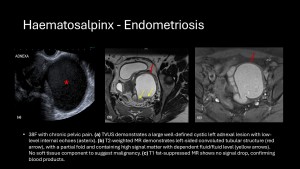
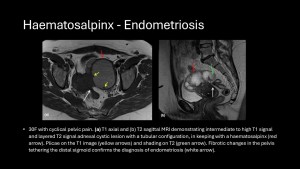
Ectopic pregnancy
Ectopic pregnancy is the implantation of a fertilised ovum outside the uterine cavity, most commonly in the fallopian tubes. Acute abdominal pain with a positive βHCG in a female of childbearing age warrants urgent investigation to exclude an ectopic pregnancy.
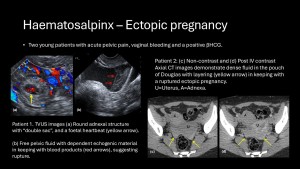
Pelvic Inflammatory Disease
Pelvic inflammatory disease (PID) is an ascending infection of the female genital tract, typically in young women.
It encompasses a spectrum of fallopian tube abnormalities from salpingitis to pyosalpinx to tubo-ovarian abscess. The most common causative organisms are Neisseria gonorrheae and Chlamydia trachomatis. Tuberculosis (TB) and actinomycosis are less frequent.
It can lead to infertility and ectopic pregnancy.
Diagnosis is predominantly clinical; however, cross-sectional imaging may be useful to assess for complications and management planning, or to exclude other infective/inflammatory pelvic conditions such as diverticulitis or appendicitis.
Salpingitis

Tubo-ovarian abscess


Tuberculosis
With an ever-rising prevalence of tuberculosis (TB) in developed countries, TB should be a differential in cases of PID. It tends to be associated with peritoneal thickening and ascites, often mimicking peritoneal carcinomatosis.
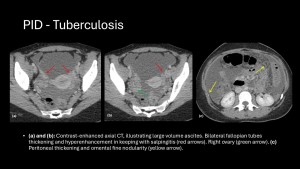
Actinomycosis
Actinomycosis is an uncommon but serious infection caused by Actinomyces spp. It should be suspected in the presence of an intra-uterine contraceptive device and with imaging features of infiltrative soft tissue components traversing fascial planes. Fistulation and hydronephrosis are common complications.
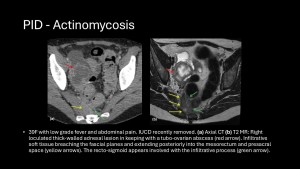
Gas in the fallopian tubes
In addition to mimicking PID, pelvic inflammatory conditions secondary to bowel pathology can directly involve the adnexal structures.
The age of the patient may hint towards pathology other than PID.

Malignancy
Fallopian tube malignancy is rare at presentation.
It can be due to either a primary, or secondary infiltration from a uterine or ovarian primary, or metastases from other sites. Malignant transformation of endometriosis can also be a rare cause.
Fallopian tube malignancy should be considered in the differential diagnoses of adnexal masses in patients with post-menopausal bleeding.
Imaging finding of haematosalpinx in a postmenopausal patient is also suspicious and the tubes should be thoroughly evaluated for irregular wall thickening or enhancing soft tissue component.
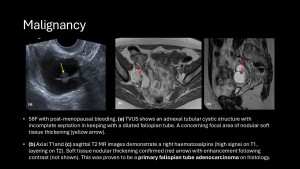
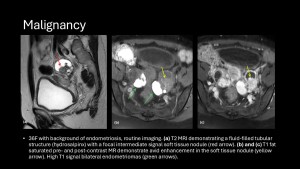
Torsion
Isolated fallopian tube torsion is extremely rare but may occur in young females or women of childbearing age. It is more common on the right, due to the anchorage of the left tube to the pelvis by the sigmoid colon and mesentery.
Risk factors include a long mesosalpinx, hypermotile tube, hydrosalpinx, PID, prior ligation, and trauma.
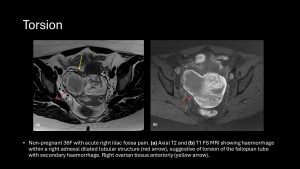
Infertility
HSG are used to investigate infertility or recurrent miscarriages. They are used to assess for uterine, or tubal pathology such as tubal blockage, hydrosalpinx, and salpingitis isthmica nodosa.
